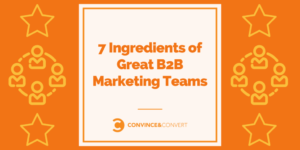All your work centers around this one focus for weeks, or even months, leading up to the “big moment.”
Then once it comes, it can feel like the entire future and success of your product depends on how the first day of the launch goes.
And while that’s not true (you can rebound from a bad launch with a good marketing strategy), the first impression will set the pace for how difficult future product marketing will be.
Because no matter how great a product is, product marketing is essential for its success.
After all, even if your product is far and away the best of its kind, how are people supposed to know that without you telling them about it?
That’s why product marketing matters, especially when first launching something new.
So how can you be sure that your next product launch gives the first impression your product deserves?
By getting organized, of course.
Every minute you spend planning and coordinating any kind of complicated project saves approximately 10 minutes of implementation time, according to time management expert Brian Tracy.
Clearly, creating a launch marketing plan is beneficial.
And the first way you’ll want to do that is with a product launch calendar, which is the easiest way to tame the chaos of launching a new product.
Here’s how to put one together.
[Tweet “Plan your product launch calendar in 5 simple steps via @CoSchedule”]
Plan Every Product Launch Campaign With This Calendar Template
All the steps below culminate in mapping out individual tasks on a calendar. And lucky for you, we already put one together. Download our launch calendar template below:
[content_upgrade_shortcode]
Table of Contents
- Step 1: Plan Your Messaging and Positioning
- Step 2: Plan Your Projects
- Step 3: Plan Your Execution
- Step 4: Plan Your Timeline
- Step 5: Plan Your Calendar
Step 1: Plan Your Messaging and Positioning
Before you even look at a calendar, before you start planning any dates or deadlines, you’ll want to clarify the strategy and details behind the product launch.
This way, once you move onto brainstorming content and other assets for the campaign, you know the big idea or message tying everything together into a cohesive campaign.
The first thing you’ll want to figure out is your product’s positioning.
Positioning is part of the “classic marketing mix,” the most important things to have defined before effectively marketing something.
Basically, your product’s positioning is a description of where it’s situated within your larger market or industry. It’s like the “you are here” sticker on a map of the competitive landscape.
Knowing your product’s positioning means knowing:
- What its main competitors or alternatives are
- How it’s similar to them
- How it’s different from them
- Why those differences make it better for certain customers

Once you know the product’s positioning, you can also come up with the launch campaign’s core messaging, or how you’re going to communicate your strategic positioning to customers, in their own language.
For example, if your product’s positioning is that it’s stronger, faster, and more secure than the competitor’s solution, messaging would be the copy on your homepage, pricing page, and more that ensures visitors know that.
When it comes to clarifying and organizing this information for a product launch, you’ll want to come up with campaign-specific answers and consolidate all that information into one document or folder. Your team will need to reference this information often throughout the launch process, and having one place for all of it saves a lot of confusion.
Step 2: Plan Your Projects
Once you know your product’s positioning and messaging, you can start coming up with ideas that communicate them in engaging and persuasive ways.
That means at this point, it’s time to start brainstorming different events, content, and other assets you’ll need to plan, create, and publish during your product launch.
The options are endless, but think about things like:
- Blog posts
- Website / landing pages
- Press releases
- Videos
- Images / photos
- Organic social media posts
- Social media ads
- Email newsletters
- PPC ads
- Customer testimonials and social proof
- Branded hashtags, filters, and gif stickers for customers to use
As you can see, the list starts to get long pretty quickly.
Especially since you’re going to have multiple assets for each of the bullet points listed above.
For example, you might have one newsletter and three social media posts for each day of the weeklong launch campaign.
Sitting and listing out everything you’ll need at once helps make sure you’re covering all your content bases.
You want to make sure you’re conveying all the important details of your messaging and positioning, along with the details of the campaign, such as when the product will be available and where.
And you likely want to repeat yourself a bit to make sure customers and followers see and remember the news.
Luckily, once you have a list of everything you want to create or publish, you can start to see where you’ll be able to reuse and repurpose messages or even entire assets.
For example, one product mockup or paragraph of copy can easily be adapted and used across multiple emails, landing pages, and social media posts.

And once you’ve written a fantastic one-paragraph description of what the product is, who it’s for, and why they should care, it can be edited into almost every piece of long-form content you create for the launch, like press releases, blog posts, newsletters, and more.
Step 3: Plan Your Execution
Once you’ve brainstormed all of the different outputs you’ll need to create for the product launch, you’ll want to break that down into individual inputs, the work that needs to be done in order to produce those assets.
That’s what the next step involves: creating a task breakdown for each asset or piece of content to get a full picture of all the work involved in the launch.
This way, when your team goes to complete the work, they know all the information they need to effectively plan and execute it and when to do so.
Go one by one through the list of assets you came up with in step 2, and add details such as:
- The individual steps required to complete the project
- How long each task will take to complete
- Which team member is responsible for it
- If any other tasks depend on it
And double-check the list to make sure you haven’t missed anything. On your first pass, you might have overlooked some small but vital tasks.
For example, a YouTube video doesn’t just need to be planned, scripted, filmed, and edited. That might be the most time intensive work, but it’s all for naught if you don’t remember to assign someone to export and upload the final video to YouTube.

You also want to remember to think about dependencies. The video can’t be filmed until it’s scripted, edited until it’s filmed, and exported until it’s edited. That’s important sequencing information to take into account.
Once you’ve listed out all the tasks required, you can arrange them by dependency (in the order they need to be completed in) to create a rough workflow to flesh out in the next step.
Step 4: Plan Your Timeline
It may seem counterintuitive not to think about dates until step 4, but waiting until now makes it much easier. It also allows your team to work with less stress and more realistic timelines.
By planning your asset creation and all the tasks involved with that first, you know how much work needs to be done and can choose a realistic launch date based on that. Since you’ve already thought about how long each task will take and who’s completing it, you’ll easily be able to see what’s possible and what’s not.
For example, if you feel strongly about creating a highly produced launch video along with multiple blog posts and emails, you probably can’t choose a date in the next few weeks.
Instead, you can decide on a launch date based on how long it actually takes to complete the work you’ve decided this launch needs.
If you’re dealing with external deadlines or launch dates from outside the marketing department, you may need to compromise on some of the ideas you came up with in steps 2 and 3. It might be necessary to scale back and produce less content or come up with simpler workflows to get it done if you’re dealing with a compressed timeline.
In that case, start from the launch date and work backwards to figure out what’s possible to create in the timeline you have.
Step 5: Plan Your Calendar
Finally, it’s time to grab your calendar and start adding due dates.
You have everything you need to plan ones your team will be able to follow, based on the timeline and tasks you’ve already outlined.
Start mapping out tasks and projects onto specific dates and times, taking into account any time estimates, dependencies, and team member assignments.
This can all easily be visualized in a marketing project management tool like CoSchedule, so that every team member can get a clear view of the project and calendar, including yourself.

As the launch campaign progresses, don’t forget to review and update the calendar regularly, taking into account any updates or changes. Launches are a time of constant prioritizing and reprioritizing!
When would that prioritizing happen?
A weekly or biweekly project meeting is a great way to keep people on track. Team members can share their progress, and the group can make any changes or adjustments that need to be made.
By making consistent progress with consistent reviews to make any plan adjustments, you’ll be able to work your way to a successful launch as smoothly as possible.
Start Launching
Product launch campaigns are some of the most important marketing campaigns your team can run, both analytically and emotionally. But with clear goals, you can create a detailed plan.
And with a detailed plan, your team can carry a new product to launch with minimum delays and headaches.
If that’s not a marketing team’s dream, I don’t know what is.
The post Product Launch Calendar: How to Plan Yours in 5 Simple Steps [Template] appeared first on CoSchedule Blog.

![You are currently viewing Product Launch Calendar: How to Plan Yours in 5 Simple Steps [Template]](https://www.dimaservices.agency/wp-content/uploads/2021/10/product-launch-calendar-header.png)


